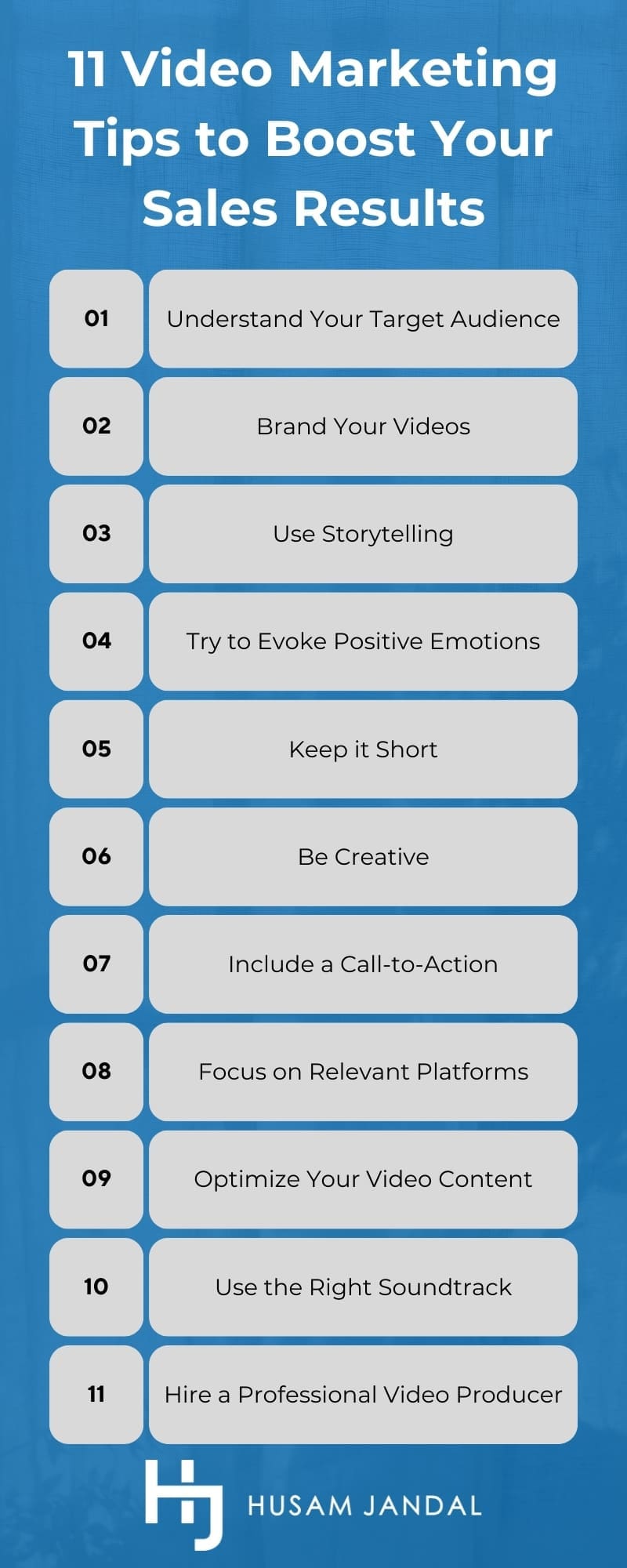 Whether you’re creating your first video or your hundredth, the right video marketing tips can take your results to the next level. On this page, I’ll go over some of the basics about how video marketing campaigns can help your business, then cover some tips for video marketing that will improve performance and reach so your sales increase too.
Whether you’re creating your first video or your hundredth, the right video marketing tips can take your results to the next level. On this page, I’ll go over some of the basics about how video marketing campaigns can help your business, then cover some tips for video marketing that will improve performance and reach so your sales increase too.
Why Should You Implement a Video Marketing Campaign?
More than 85 percent of businesses currently create video marketing content, per a recent State of Video Marketing Survey by Wyzowl. Overall, 99 percent of them plan to use video more in the coming year, and 79 percent of those who don’t presently have a video marketing strategy plan to implement one. Momentum behind the video content movement is growing, and the reasons for this are simple.
People Consume and Appreciate Video Content
Video traffic accounts for more than 80 percent of all consumer Internet traffic, according to Animoto’s State of Social Video Marketer Trends report. Their research shows that 65 percent of people watch at least one video per day and that consumers rate it as the most helpful form of content when they’re shopping online.
Videos Boost Engagement and Return on Marketing Investment (ROMI)
Many businesses use leads and sales to gauge the benefit of specific marketing activities. That works in most cases, but social media marketing is about building brand awareness and relationships. These things contribute to greater sales, but because digital marketing is a large ecosystem in which the customer connects with you via multiple channels and touchpoints, you’re not always going to see the sale coming directly from social media or be aware that social media influenced the customer. Therefore, you want to use social media engagement as your primary metric for determining success.
Videos dramatically increase engagement. For example:
- Tweets with videos get ten times more engagement than their counterparts, according to Twitter. Ads on the platform that leverage video have a 50 percent lower cost-per-engagement too.
- LinkedIn ads with videos see two times greater engagement and have a 3.5 times higher conversion rate.
- Facebook video posts have an average engagement rate of a little over six percent per Yans Media, compared to the general average of just 0.13 percent.
A Strong Video Marketing Strategy Boosts Sales
Again, engagement should be the primary metric for determining social media marketing success, but there are sales-focused reasons for using videos in your content marketing efforts too.
For example, more than 80 percent of marketers say videos help with lead generation, according to OptinMonster. Two-thirds say it helps them generate more qualified leads, while more than half say it increases brand awareness. More than 90 percent say they’ve landed a new customer after sharing a video as well.
We see similar sentiments on the consumer side. Out of all forms of content, customers say video ads are the number-one way they discover the brands that they purchase from, per the State of Social Video Marketer Trends report. After discovering a new brand, more than a quarter of people will either head to the business’s website or YouTube channel to learn more. Because of these things, video is the number-one form of content for ROMI too.
11 Video Marketing Tips to Boost Your Sales Results

Now that we’ve explored why videos matter, let’s look at some tips for video marketing that can help your business maximize ROMI and get better results overall.
1. Understand Your Target Audience
The effectiveness of all your digital marketing campaigns hinges on knowing your audience, addressing their concerns, and communicating with them in a way that resonates. This is why you should always create customer personas before implementing campaigns of any type.
A well-designed persona will tell you which platforms your customer uses, what they want to hear, what they’re trying to accomplish, and more. Any video you create should tie back to these points.
2. Brand Your Videos
Good branding sets your business apart, creates consistency, increases trust, and more. But you can’t simply pop your logo in the corner of your video and consider it done. Think of effective branding more as infusing your videos with your brand ethos. It’s the overall design and feel of the video, the language you use, and the energy your content emanates.
As digital marketers, we should always experiment to see if there are ways to boost the results of our campaigns and strategies, but you also want your videos to be instantly identified as yours. You want your clients and leads to see a video in their feed and instantly make a connection to your company. For this reason, creating templates or guidelines for your videos to ensure they remain consistent over time is a good idea.
3. Use Storytelling
When big brands create videos, even to promote a specific product, they don’t just show you the product features and tell you why you should buy it. For example, Apple’s “Now all you need is iPhone” video keeps the iPhone front and center while cycling through clips of everyday people viewing Apple Fitness+ content as they work out. Through roughly 30 seconds of visual storytelling, you learn how Fitness+ works and why it can work for you without the brand telling you so.
Nike uses storytelling slightly differently in its “Cosmic Unity 2 | Behind the Design” video. They don’t walk you through the shoe’s features and tell you why they’re good. You see the shoe’s designers explaining their process and why it was important to them to include specific features. In the B roll (interspersed clips between the main interview clips), you also see the shoe’s features and an athlete wearing the shoes while playing basketball.
4. Try to Evoke Positive Emotions
You’ve probably heard that people make buying decisions based on emotions rather than logic. Most research today backs this up. But did you know that campaign effectiveness increases dramatically when you focus on emotions? Whereas campaigns that make a rational argument are effective 16 percent of the time, and those that blend rational and emotional arguments are effective 26 percent of the time, those that are purely emotional boast a 31 percent effectiveness rate per Neuromarketing research.
The question, then, is which emotion you want to evoke. Some marketers use fear or unpleasant feelings to sell a solution. Statistically, it doesn’t work.
For example, two computer security ads were put head-to-head in one test. The first focused on empowering people to take control of their security. The second focused on how a computer can be a weapon. The first was three percent more effective, per Awario research.
The same approach was taken with insurance ads. One ad used empowerment and a message about protecting one’s family. The second one used “don’t wait until it’s too late” messaging. The first was 91 percent more effective.
The theme of positivity and empowerment was present in the Apple and Nike videos mentioned earlier too. Apple didn’t say, “Get an iPhone or your workouts won’t be as good.” Nike didn’t say, “Your current shoes are bad for the environment,” or “Your physical performance will suffer without these shoes.” You feel good after watching their ads or perhaps even empowered.
5. Keep it Short
Videos under two minutes have an average engagement rate of 70 percent per Wistia. After that, there’s a sizable drop in engagement. Because of this, it’s typically better to keep your videos as concise as possible.
In other words, if you’re teaching a topic that might normally take just under ten minutes in a how-to video, you might be better off breaking it up into individual videos that are under two minutes in length. Apple did a great job of this, keeping its video under 40 seconds. Nike’s video came in at nearly three minutes. It’s compelling and beautifully made, but it doesn’t have as many views as shorter videos of the same series. Perhaps it would have performed better if they’d found a way to trim it down some.
With that said, some topics genuinely require more time. If you can’t get your video down to under two minutes, you have until roughly the six-minute mark before the next major drop in engagement hits. That doesn’t mean you should produce a five-minute video if it can be a three-minute video instead. Be considerate of your viewers and their time. If you’re delivering value, it’s ok to go a little longer.
Lastly, the platform makes a difference here too. For example, TikTok viewers tend to prefer very short videos that are well under a minute long and sometimes only mere seconds per Listen First research. Twitter and Facebook video viewers aren’t far behind, while YouTube viewers gravitate toward meatier content.
6. Be Creative
Viewers need two big things to stick around after the video starts. First, what they see on screen should meet their expectations based on the thumbnail and any written copy you’re using. Secondly, there must be a hook—something to pull them in and pique their interest.
Viewership will generally drop off as the seconds tick, but the more memorable, unique, and helpful your content is, the more likely they are to stick around to the end and share it with others.
If you’re stuck or in need of inspiration, consider using a tool like FlexClip that offers pre-made templates you can customize to fit your needs.
7. Include a Call-to-Action
The person consuming your content should always be guided to their next step. The next step will vary depending on what stage of the customer journey your viewer is in, the type of video they watched, where they watched it, and other details.
For example, if the video was designed for someone just being introduced to your brand, you might want to direct them to more content or encourage them to subscribe to your newsletter. If the viewer is likely at the later stages and nearing readiness, you can start offering them things like demos, product guides, and comparisons.
8. Focus on Relevant Platforms
Remember to trace your video back to the persona. Which platforms does your persona use? You don’t need to post it everywhere – only the sites your persona visits. This allows you to conserve resources and apply them where they’ll have maximum impact.
9. Optimize Your Video Content
Your videos will be more discoverable and get greater engagement if you optimize them. Some video marketing tips here include:
- Using an SEO keyword in the file name for the video
- Including a keyword in the title
- Optimizing the description with keywords
- Creating a custom thumbnail image
- Using tags and hashtags
10. Use the Right Soundtrack
Music pulls your story together, sets the mood, and impacts how the viewer feels about what’s happening on screen. The same scene can take on totally different meanings depending on your selected music.
Make sure the music you select aligns with your intent and, of course, that you have the legal right to use it.
11. Hire a Professional Video Producer
Of all the video marketing tips covered here, this last one is the most important. You can outsource your video marketing or handle it in-house, but if you want professional results, you need a professional to create your videos. Depending on the type of videos you’re creating, you may even need a team that includes writers, producers, animators, voice actors, editors, and so forth. Because most small businesses don’t need a full video creation team, nor the budget, it usually makes more sense to outsource to a pro.
Get Help Building Your Dream Team and Amplifying Your Digital Marketing
I help businesses by ensuring they have the right resources and processes in place to take their digital marketing and organization to the next level. This means I address the groundwork, like creating personas that set the foundation for stronger, more cohesive marketing, and build digital marketing dream teams that fuse in-house and outsourced talent. With the right people in place, your digital marketing will help your business meet its goals, whether you want to improve retention, strengthen your brand, grow sales, or have other targets. If you want to get better results from your video marketing initiatives or overall digital marketing, contact me for a complimentary consultation.


































































